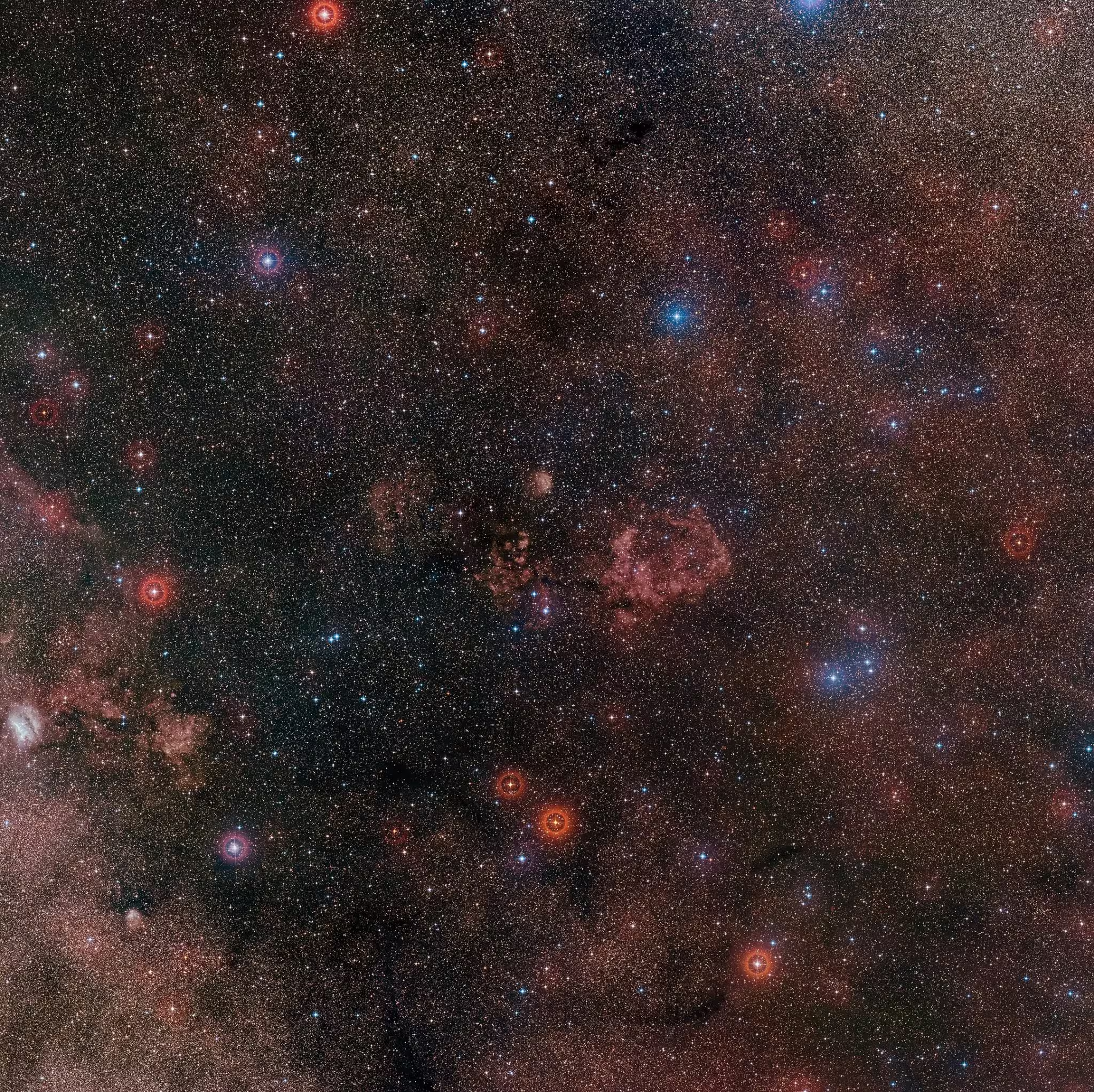5 Minutes
Astronomers have captured a striking new view of a red, bat-shaped cloud of gas and dust — a stellar nursery where young stars are energizing their surroundings. The image, taken from ESO’s Paranal site in Chile, reveals dramatic filaments, glowing hydrogen emission and hidden pockets of star formation that together create an uncanny cosmic silhouette.
A spooky silhouette in the southern sky
Nicknamed the “cosmic bat,” this nebulous complex sits roughly 10,000 light-years from Earth between the constellations Circinus and Norma. On the sky it spans an area comparable to around four full Moons — large enough that wide-field instruments were required to capture its full shape. In optical images the cloud glows deep red because energetic young stars ionize hydrogen atoms in the surrounding gas; those recombining atoms emit light strongly at the Hα wavelength, which shows up as red in composite images.
Dark, thread-like lanes of dust cut across the glow; these are cooler, denser filaments where dust grains block starlight and where further star formation may be ongoing. To the human eye the arrangement looks uncannily like a bat in flight — RCW 94 forms a right wing, RCW 95 the central body — while other parts of the complex currently lack catalog names.
How the image was made: instruments and surveys
The final composite is the result of combining optical and infrared surveys. The VLT Survey Telescope (VST) at ESO’s Paranal Observatory provided wide-field visible-light data through the VPHAS+ survey, which maps Hα and other filters across the southern Galactic plane and bulge. Mounted on the VST is OmegaCAM, a 268-megapixel camera optimized for large, high-resolution mosaics of the sky.
Infrared information from ESO’s Visible and Infrared Survey Telescope for Astronomy (VISTA) — gathered as part of the VVV (VISTA Variables in the Vía Láctea) survey — was layered on top of the optical data to reveal structures hidden inside the densest clouds. Infrared wavelengths penetrate dust more readily than visible light, exposing embedded young stars and the warm interior of the nebula that remain invisible in optical images.

This image from the Digitized Sky Survey (DSS) shows the region of the sky around the RCW 94 and RCW 95 nebulae, seen here at the center of the image. The nebulae are part of a larger complex of clouds resembling a bat, with RCW 94 representing the right wing and RCW 95 the body, respectively. Credit: ESO/Digitized Sky Survey 2
Why astronomers care: star formation and feedback
Regions like the RCW 94/95 complex are laboratories for understanding how massive stars influence their environment. Young, hot stars produce intense ultraviolet radiation and stellar winds that ionize and push on surrounding gas, a process known as stellar feedback. Feedback can both trigger further star formation by compressing nearby gas and halt it by dispersing the cloud. Observations across optical and infrared bands let astronomers map ionization fronts, locate newly formed protostars, and estimate ages and masses of stellar populations.
Because the VPHAS+ and VVV surveys are public, researchers worldwide can access the datasets to search for young stellar objects, jets, or compact clusters embedded in the cloud. The combination of large-area coverage and high sensitivity is especially valuable for identifying rare stages in massive-star formation.

This chart shows the location of the RCW 94 and RCW 95 nebulae between the Circinus and Norma constellations. This map shows most of the stars visible to the unaided eye under good conditions. The location of the nebulae is marked with a red circle. Credit: ESO, IAU and Sky & Telescope
Future prospects and related technology
Follow-up observations at higher spatial resolution or different wavelengths could reveal finer details: radio interferometry can trace cold molecular gas and outflows from protostars; mid-infrared imaging identifies warm dust and embedded objects; and spectroscopy measures gas velocities and chemical composition. Instruments such as ALMA, the James Webb Space Telescope and future ELT-class telescopes are well suited to dissecting the densest, most obscured regions of the complex.
Expert Insight
"Wide-field surveys like VPHAS+ and VVV are essential for finding and contextualizing interesting star-forming regions," says Dr. Elena Martínez, an astrophysicist who studies massive-star formation. "Once a striking target is identified, follow-up with high-resolution facilities lets us test models of feedback and cluster formation. The 'bat' is not just visually compelling — it’s scientifically rich."
The haunting image is a reminder that spectacular cosmic patterns often arise from ordinary physical processes: gravity, radiation, dust and gas combined over millions of years. For the public, the nebula is a seasonal delight; for astronomers, it’s another piece in the puzzle of how stars — including massive, short-lived ones — shape the galaxy.
Source: scitechdaily
Comments
mechbyte
is this even real? 10,000 light years feels kinda close, or is it just a projection effect? curious about the raw, unprocessed images
astroset
wow, didn't expect such a spooky nebula... the bat silhouette is eerie and beautiful, those glowing Hα filaments look alive, makes me wanna learn more


Leave a Comment